So far I had traveled across two South Carolina counties on The Tobacco Trail, aka US Highway 301. I still had a long way to go, though. I was able to get through about a third of Orangeburg when we had a death in the family. Yesterday I was able to go knock out another huge chunk of the highway.
I had only made it part of the way into Orangeburg when I had to cut my trip short. This bit of the tale uses photos from that trip, so older shots I had of the stretch, and combines those with photos I took this week.
First, a bit of a recap…
Highway 301 used to be one of the main north-south routes, connecting Baltimore, Maryland with Sarasota, Florida. Travelers liked this route better because it bypassed major metropolitan areas, and was considered a quicker route. Lots of mom-n-pop motels, diners, and service stations popped up along the route to cater to these travelers. A business association formed, designating the route as The Tobacco Trail because large portions of it passed through tobacco producing regions. The construction of I-95 caused many of the amenities to close, and many now sit abandoned along the 301 corridor.
301 enters Orangeburg County from Bamberg County at the South Edisto River bridge. Having merged with US 601 just south of the town of Bamberg, the two highways run concurrently through Orangeburg. Just a couple of miles from the river is the turn off for the town of Cope.
Cope sits about a mile of of Highway 301. Established in 1894 by Jacob Martin Cope, the town was built around cotton farming. A gin and a depot for transporting the cotton by rail making up its most important buildings. Passenger rail traffic died out as more people to to automobiles along highways like 301. However, the depot was still active through the 1960s for transporting cotton. The depot was listed on the National Register of Historic Places in 2001.
Near the depot and along the tracks is the ginning facility built by J. I. Vallentine in the early 1900s. In 1911 he built a general store to serve the community. The store has been preserved by members of the Vallentine-Cope family, and is open for tours upon request if you call ahead.
When I visited in 2012 it was like stepping back in town. Everything seemed to be in good order, but there was no activity, and there were no people.
Back on 301, the miles of farmland roll past without much break until you near the community of Cordova. On the north side of the highway is the Coffee Pot Diner. According to information on Sciway.net, the diner was built around 1950 by Emily and Fredrick Griffin. They were a British couple, and initially wanted to set up a tearoom. However, in this area they thought coffee and a cafe would be more successful. The diner was in operation until 1979. The building is now owned by the Gray family, who own the surrounding farmlands.
Several miles further up, also on the north side of the highway, is the old Zion Methodist Church. This is a straightforward Greek Revival Style wood frame building. Built in 1880, the church hasn’t held regular services since the 1930s.
I’m not sure why this one isn’t on the National Register. There is a historical marker, which states that this is one of the oldest Methodist churches in Orangeburg County.
Just a couple more miles further and I was in the outskirts of Orangeburg. Actually, I was in the community of Edisto, which lies on the other side of the river. Here I found an abandoned motel on the north side of the highway.
According to the Orangeburg tax maps, this was the former Cotton Boll Motel. I had come across several vintage postcards for this location.
At the intersection of Highway 301 and Neeses Road, on the south side of the road is another motel. This one seems to have fared better, and is still in business as the Crown Inn.
I’m pretty sure this was once the Edisto Motel, as shown on old postcards.
At some point it had been the Orangeburg Motor Court.
Just up from this I found a former restaurant location. The way it’s painted now I suspect that its most recent incarnation has been as a nightclub.
I crossed the North Edisto River into the city of Orangeburg, proper. I decided to check out river access to the south. The city maintains a landing, and there is a disc golf course in the park along the river. There are also picnic tables and other amenities.
On the north side of 301 are the famous Edisto Gardens. I had heard about these all my life, but had never visited until today. The gardens are now owned and maintained by the City of Orangeburg, and cover 175 acres along the banks of the river. The area had been a park commemorating a Confederate skirmish at the river, but in 1920 Andrew Dibble planted five acres with azaleas. An extensive rose garden was planted in the 1950s, and the gardens now host the Orangeburg Festival of Roses.
This was a case where I wished I’d had more time to explore. I had a lot of ground to cover, and didn’t want to get distracted by one location. Even so, I got out and wandered for a minute or so. There were roses in bloom.
Here I ran into a bit of a dilemma, as far as route was concerned. In fact, I didn’t discover this until AFTER I had gotten back home and checked my maps. Originally 301 ran through the heart of the city along Russell Street. Starting in 1954 it was rerouted to bypass the city. The route I had marked, and the one with which I was familiar was the bypass route. To my knowledge, I’ve only driven through the downtown area once. I did note a classic Piggly Wiggly on Russell Street, but don’t remember any old motels. I didn’t identify any additional locations with a quick check of Google Earth, either.
Back on my original route, though, I encountered a second dilemma. There are lots of dead and repurposed businesses along this stretch, but how much of that is accountable to the demise of the Tobacco Trail as a major route? When you get into a larger city like Orangeburg, there is going to be a natural attrition. Businesses don’t last forever. I think about Greenville and the stretch of old motels and dead motels on the outskirts of town, yet it’s a nationally award winning city with lots of first class accommodations. I could do an entire series of posts just on the old motels here.
Regardless of the how and why, I stuck to my original goal of documentation. Just past Edisto Gardens I found a rather large facility. It had been a former Econolodge, but now had a sign that read Orangeburg Hospitality Inn and Suites. The place didn’t look like it was open, yet a grounds crew was busy cutting grass and trimming shrubs.
Further along I spotted a restaurant that had interesting architecture. It could have been one of those 1970s era steak houses, but the name reminded me of the Tobacco Trail.
Just beyond was another series of motels. Again, the question of whether or not these were really Tobacco Trail motels came up. South Carolina State University and Claflin University are just around the corner, and many of these would cater to visitors. In fact, this former Holiday Inn once served as housing for SC State, and is still owned by them.
Here’s a postcard showing it in its former glory:
Across from the old Holiday Inn was the SunMoon Motel.
Further on out I found a Super 8 Motel.
Both of these looked a bit too new to have vintage postcards, so I didn’t really look for them.
I had only made it through half of Orangeburg County, but there was more to see. Rather than make this an extremely long post, I think I’ll end here and break it into two posts. In Part Two, I head out of Orangeburg toward the madness that is Santee.













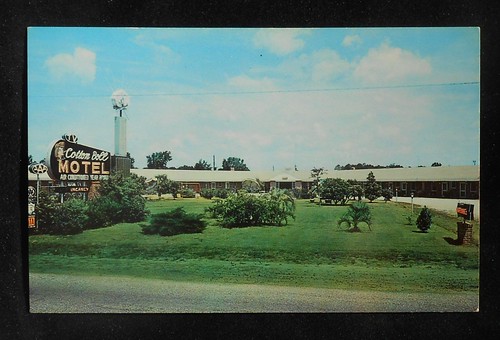


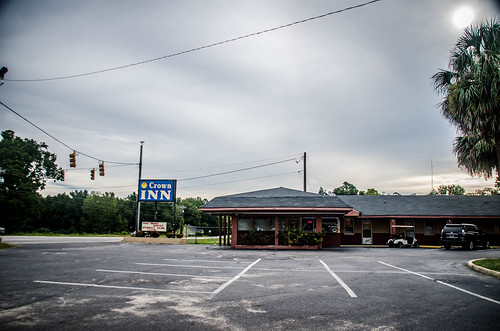


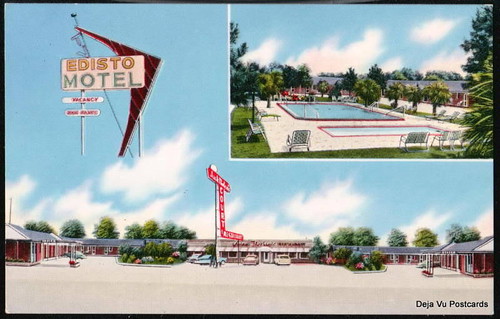



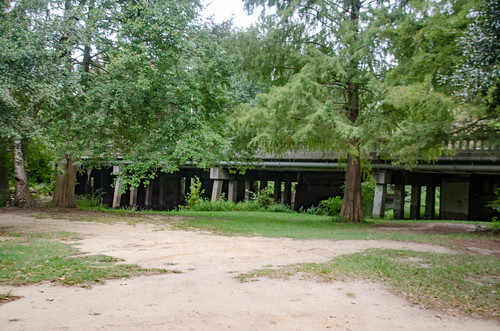



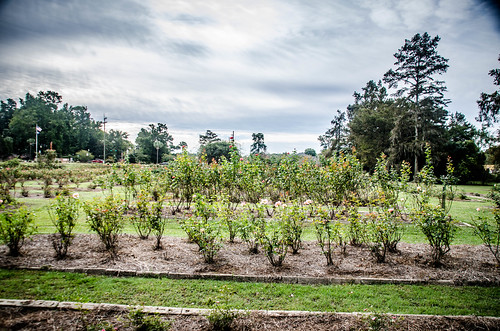





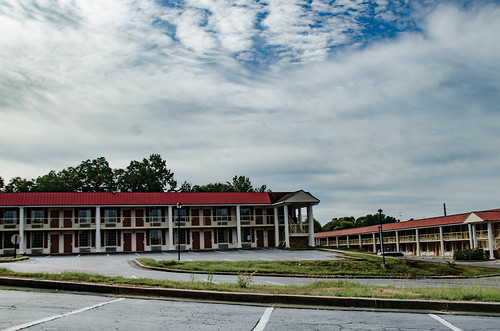







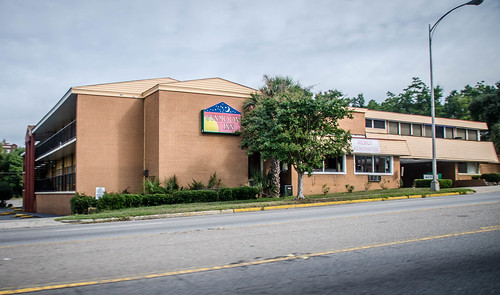

Nice to include the Coffee Pot. I have no evidence other than hearsay but a now deceased acquaintance claimed there was once a motel behind the Coffee Pot. I have seen an apparently abandoned building in the distance behind it that appears to be of similar architecture (i.e., cinderblocks), and it looks very much like a cabin-style motel building. If so, there would have been several of them. Glad the Gray family has preserved the Coffee Pot. That little building has long been a “landmark” along 301 and I never fail to look for it when I pass that way.
Great article! Really enjoyed it. The EconoLodge motel was a former Holiday Inn. You can tell by the signature brown ridged base on the sign. They used that style for many years. I suspect they moved there after leaving what is now the university property just down the street.
Great article on what is my favorite ghost highway. We’ve no doubt taken many of the same pictures. I was in fact a guest of the old Orangeburg Holiday Inn in 1966 and ’71. In recent years I’ve cover the highway north of Jacksonville, FL numerous times. As you probably have discovered, Allendale more or less represents the epicenter of post-Interstate decay on the route. The long approach to the original 1930’s swing bridge over the Savannah River south of town is a rewardingly surreal yet easy walk that shouldn’t be missed.